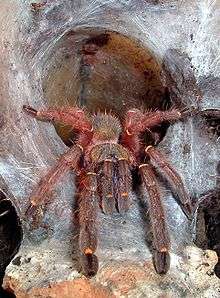Ephebopus
Ephebopus is a genus of northeastern South American tarantulas that was first described by Eugène Louis Simon in 1892.[2] Its relation to other tarantulas is one of the most uncertain in the family, and it has been frequently moved around and has been placed in each of the eight subfamilies at least once.[3]
| Ephebopus | |
|---|---|
 | |
| Ephebopus cyanognathus | |
| Scientific classification | |
| Kingdom: | Animalia |
| Phylum: | Arthropoda |
| Subphylum: | Chelicerata |
| Class: | Arachnida |
| Order: | Araneae |
| Infraorder: | Mygalomorphae |
| Family: | Theraphosidae |
| Genus: | Ephebopus Simon, 1892[1] |
| Type species | |
| E. murinus (Walckenaer, 1837) | |
| Species | |
|
5, see text | |
Description
They normally grows to a legspan of 10 to 15 centimetres (3.9 to 5.9 in). Most live in burrows, though E. murinus spends an adolescent stage living in trees. Like many other New World tarantulas, these spiders will brush urticating hairs from their bodies as a defense against potential predation. However, these spiders are unique because instead of the abdomen, these hairs are located on the pedipalps, and are removed by rubbing the palps against the chelicerae.[4]
Species
As of March 2020 it contains five species, found in Brazil, Suriname, Guyana, and French Guiana:[3][1]
- Ephebopus cyanognathus West & Marshall, 2000 – French Guiana
- Ephebopus foliatus West, Marshall, Fukushima & Bertani, 2008 – Guyana
- Ephebopus murinus (Walckenaer, 1837) (type) – French Guiana, Suriname, Brazil
- Ephebopus rufescens West & Marshall, 2000 – French Guiana, Brazil
- Ephebopus uatuman Lucas, Silva & Bertani, 1992 – Brazil
In synonymy:
- E. bistriatus (C. L. Koch, 1838) = Ephebopus murinus (Walckenaer, 1837)
See also
References
- "Gen. Ephebopus Simon, 1892". World Spider Catalog Version 20.0. Natural History Museum Bern. 2020. doi:10.24436/2. Retrieved 2020-04-12.
- Simon, E (1892). Histoire naturelle des araignées. Paris: Roret. doi:10.5962/bhl.title.51973.
- West, R. C.; et al. (2008). "Review and cladistic analysis of the Neotropical tarantula genus Ephebopus Simon 1892 (Araneae: Theraphosidae) with notes on the Aviculariinae". Zootaxa. 1849: 39–58.
- Foelix, Rainer; Rast, Bastian; Erb, Bruno (2009-12-01). "Palpal urticating hairs in the tarantula Ephebopus: fine structure and mechanism of release". The Journal of Arachnology. 37 (3): 292–298. doi:10.1636/sh08-106.1.